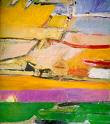 I discovered, reading a piece from the Wall Street Journal (accessed via Arts & Letters Daily), that the Obamas have borrowed a painting by Richard Diebenkorn to hang in the White House. Diebenkorn's one of my very favourite painters, and I've written a short essay about him, for Untitled: Perspectives. You can find it here. Or you can just read on...
I discovered, reading a piece from the Wall Street Journal (accessed via Arts & Letters Daily), that the Obamas have borrowed a painting by Richard Diebenkorn to hang in the White House. Diebenkorn's one of my very favourite painters, and I've written a short essay about him, for Untitled: Perspectives. You can find it here. Or you can just read on...DIEBENKORN DOES THE WHITE HOUSE
Diebenkorn's a fascinating painter, one of my absolute favourites. He's from the generation of the Abstract Expressionists and in one sense produced a West Coast version of AE which took a long time to get recognised. That may be because his Berkeley work, from the 50s and 60s, is more representational than one expects from Abstract Expressionism. Even his Ocean Park series, from the 60s and 70s, still features recognisable parts of landscape, more than a hint of Post-Impressionism in them. They have a relaxed, west coast feel to them; not the intensity of, say, Rothko (who did grow up in Portland, Oregon, where Diebenkorn was born, after all), whom they sometimes recall. There's also a touch of Franz Kline about some of them, in their structural, almost architectural, power; and it's interesting that the Obama's have apparently requested a Kline from Chicago, on approval, as it were. Apparently, Barack took Michelle to the Art Institute on one of their first dates.
The Obamas have also borrowed sculptures by Jasper Johns and Degas, and works by Josef Albers, Louise Nevelson, Rauschenberg and, oddly, a red painting by Edward Ruscha with words like 'I think' 'maybe' and 'yes' on it.
 This
is Obama's Bob the Builder approach to art. Can we fix it? Maybe we
can! They've also selected a couple of works by a little-known black
American artist, Alma Thomas, Sky Light (left) and the Chubby
Checker-inspired 'Watusi Hard Edge'. There was an interesting piece in
the Wall Street Journal which, while noting the pressure to make
political gestures when presidents pick art, was more concerned with the
potential increase in market value for the artists. This, I suppose,
would be more of a help to those who are still alive, though the works
themselves need to be at least 25 years old before they can be added to
the White House's permanent collection, lest presidents be seen to be
playing the art market like British MPs play the property market with
taxpayer funding.
This
is Obama's Bob the Builder approach to art. Can we fix it? Maybe we
can! They've also selected a couple of works by a little-known black
American artist, Alma Thomas, Sky Light (left) and the Chubby
Checker-inspired 'Watusi Hard Edge'. There was an interesting piece in
the Wall Street Journal which, while noting the pressure to make
political gestures when presidents pick art, was more concerned with the
potential increase in market value for the artists. This, I suppose,
would be more of a help to those who are still alive, though the works
themselves need to be at least 25 years old before they can be added to
the White House's permanent collection, lest presidents be seen to be
playing the art market like British MPs play the property market with
taxpayer funding.Call me predictable, but I find it interesting that I immediately make connections between Diebenkorn, Rohko, and Kline--my favourites of the painters of my lifetime.
 There's also a nice parallel to be made with Cy Twombly (about whom I wrote last August; you can find that here),
another AE artist working at a remove from the mainstream, outlasting
them, and in an environment of relaxed bright light. You can see a bit
of Twombly, and even more of Charles Demuth, in many of the Ocean Park
paintings (right).
There's also a nice parallel to be made with Cy Twombly (about whom I wrote last August; you can find that here),
another AE artist working at a remove from the mainstream, outlasting
them, and in an environment of relaxed bright light. You can see a bit
of Twombly, and even more of Charles Demuth, in many of the Ocean Park
paintings (right).That Diebenkorn's work should appeal to Obama, raised in Hawaii and colleged, at first, in California, doesn't come as a great surprise. I remember in the early 90s spending a weekend in Healdsburg, mainly because Diebenkorn lived there. The Clos du Bois winery was there too, and between them and the nice little Inn I stayed in, I decided Healdsburg would be a fine place to live. I wonder if it's still the same, with a Disney 1950s feel to it. Oddly, that's the kind of feeling Diebenkorn draws from me; I find his work both contemplative and soothing, both of which I assume would be a boon to someone with Obama's job description. But the idea of having the great galleries of America as a shopping gallery makes me think the job might almost be worth it.

1 comment :
It is funny what you can learn from the WSJ.
Post a Comment